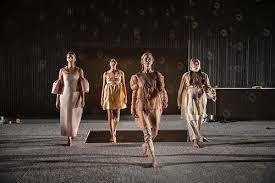This is what Brian Seibert in NYT had to say about ‘The Mood Room’ – a dance production by Annie-B Parson, based on a text by Guy de Cointet. Perhaps more theater than dance.
‘Something is clearly wrong. The sisters are anxious and depressed. They can’t always tell one another apart; their own identities aren’t stable. One sister has become allergic to the sun. The water isn’t clean. They have many ideas about how to fix the problems: doctors and diets, new lighting and other purchases and changes of scene, vacations to exotic locales or just a retreat to the room of the title.
Even without a program note, you might guess from the sisters’ speech and from the interior décor that we are in the early 1980s — a 1980s that hasn’t ended. The production, which Big Dance Theater debuted at BAM Fisher on Tuesday, takes its text from “Five Sisters,” a 1982 work by the Conceptual artist Guy de Cointet. Born and raised in France, he lived in Los Angeles and captured the self-absorption of some of the city’s inhabitants with a mixture of amusement and alarm.’
(…)
‘That pausing and posing is pure Parson. The sisters dance a lot here, sometimes in girl-group formation, step-touching as a disco ball revolves. But every second of the show is tightly choreographed, tightly controlled, down to how they hold their water glasses and dangle their feet. The anxious mood derives from this exertion of control, especially as the sisters react to and remark upon shifts in light and sound.
The addition of music by the experimental laptop artist Holly Herndon is an inspired choice. Full of vintage noises, it’s like a spliced memory reel of the era, echoing Laurie Anderson without sampling or recognizable quotation. The sisters keep characterizing it differently (“what odd music,” “what thoughtful music”) and yet accurately.
The cast is also expert: Kate Moran as the sister with the sun allergy, Elizabeth DeMent as the sleepy-eyed workaholic, Myssi Robinson as the clean-lined dancer with hearing and hip problems, Michelle Sui as the painter. Theda Hammel, appearing briefly without the other sisters, introduces a welcome, looser humor — at once the most Chekhovian and contemporary, dishing about a guy she’s met, rearranging household objects before saying, “That’s how I remember it.”
That earns a laugh, but otherwise, humor is thinly spread. Across an hour, sisters accumulate and one finally leaves, but nobody really changes. Which is the point, a static point perhaps more suited to museums and art galleries than a theater.’
Read the article here.
Although I dozed off for five minutes or so I was intrigued by the show, that was indeed more a performance that you might expect in a museum than theater.
Also, the critique of a self-absorbed society felt slightly dated and worn-out.
The 1980s and Chekhov never ended, bot consolation and nightmare, sort of.
